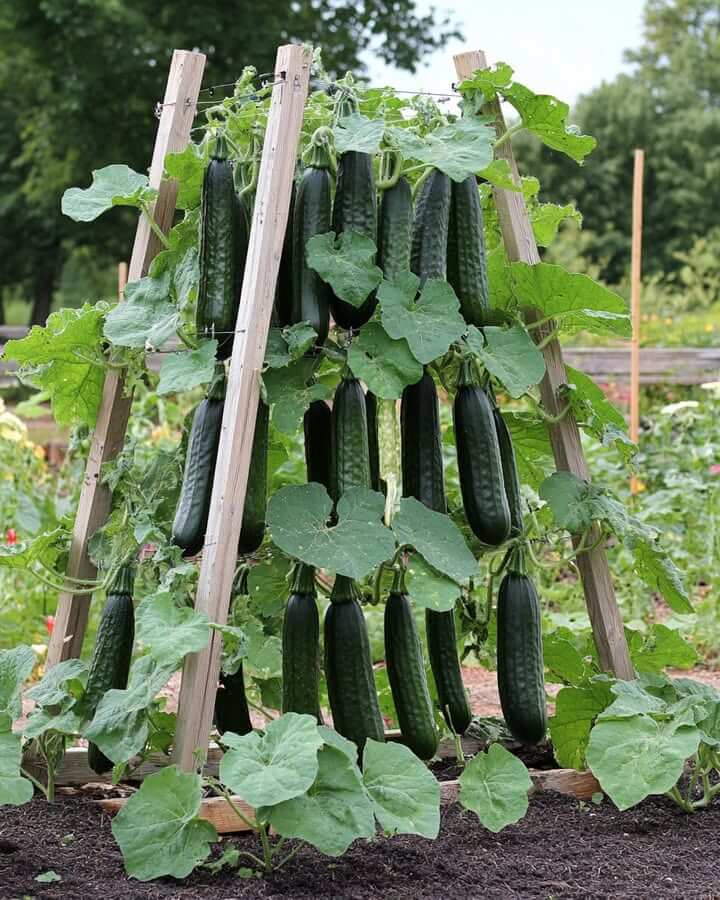Building a cucumber trellis is an excellent gardening method that trains cucumber vines to grow upward on a support structure. This approach saves space, promotes healthier plants, and makes harvesting easier. Whether you’re an experienced gardener or a beginner, creating a cucumber trellis can improve both your gardening experience and your harvest.
Benefits of Using a Cucumber Trellis
Using a trellis offers several benefits. First, it maximizes garden space by allowing cucumbers to grow vertically, which is perfect for smaller gardens. It also improves air circulation around the plants, helping reduce the risk of fungal diseases. Additionally, keeping cucumbers off the ground prevents rot and makes them easier to pick.
Common Mistakes and How to Avoid Them
- Using a Weak or Unstable Structure
Cucumbers can become heavy once they start producing fruit, and a weak trellis might collapse under their weight.
Solution: Choose strong materials like wooden frames, metal stakes, or PVC pipes for a stable structure. - Not Providing Enough Height
Cucumbers can grow as tall as 5-6 feet, sometimes more.
Solution: Ensure the trellis is at least 5-7 feet tall to support vertical growth and avoid tangled vines. - Poor Spacing Between Plants
Planting cucumbers too close together can reduce airflow, which can lead to mildew and other diseases.
Solution: Space plants 12-18 inches apart to allow for proper growth and airflow. - Using the Wrong Trellis Material
Thin strings or plastic netting can cut into the vines or break over time.
Solution: Use more durable materials like metal mesh, wooden lattice, or cattle panels. - Failing to Train the Vines Early
If you wait too long to guide the vines, they may sprawl on the ground or become tangled.
Solution: Gently wrap young vines around the trellis as soon as they begin growing. - Not Providing Enough Sunlight
Cucumbers need 6-8 hours of direct sunlight each day to thrive.
Solution: Place the trellis in a spot that gets the most sunlight. - Overcrowding the Trellis
When too many vines compete for space, they can shade each other, resulting in fewer cucumbers.
Solution: Trim excess leaves and ensure plants are spaced appropriately. - Letting Cucumbers Hang Too Low
If cucumbers touch the ground, they may rot or attract pests.
Solution: Lift fruits higher on the trellis as needed to keep them off the ground. - Neglecting Pest and Disease Control
Trellised cucumbers are less likely to attract pests, but problems like aphids and powdery mildew can still occur.
Solution: Regularly inspect the plants and use organic pest control methods as needed. - Improper Watering
Cucumbers on a trellis might dry out faster due to increased airflow.
Solution: Water deeply and consistently, especially at the base of the plant.
Materials for Building a Cucumber Trellis
To build a sturdy cucumber trellis, you’ll need wooden stakes or metal poles, wire mesh or garden netting, zip ties or garden twine, and a hammer or mallet. These items are commonly found at most garden centers or hardware stores.
Choosing the Right Location for Your Trellis
It’s crucial to place your cucumber trellis in an area that receives full sunlight for at least 6-8 hours a day. The site should have well-draining soil and be protected from strong winds to avoid damage to the trellis or plants.
Step-by-Step Guide to Building a Cucumber Trellis
Here’s how to construct your cucumber trellis:
Preparing the Ground
Start by clearing the area of weeds and debris. Loosen the soil with a garden fork and mix in some compost to improve the soil’s fertility. Mark the spots for the trellis posts, making sure they are spaced evenly.
Building the Frame
Drive the wooden stakes or metal poles into the ground where you’ve marked the post locations, making sure they are firmly in place. The height of the stakes should be around 5-6 feet, depending on how tall you want your cucumbers to grow. For extra support, connect the tops of the stakes with horizontal beams.
Attaching the Support Structure
Attach wire mesh or garden netting to the frame using zip ties or garden twine. Make sure the mesh is taut and securely attached so it can support the climbing cucumbers. The openings in the mesh should be large enough to let the vines grow through, but small enough to support them.
Securing the Trellis
Once assembled, ensure the trellis is stable. You may need to reinforce the base with extra soil or rocks to keep it steady in windy conditions and to bear the weight of the plants as they grow.
Planting and Training the Cucumbers
Plant cucumber seeds or seedlings at the base of the trellis, following recommended spacing guidelines. As the plants grow, gently guide the vines onto the trellis, securing them with garden twine if necessary. Regularly check on the plants and adjust their positioning to ensure they grow evenly along the trellis.
Maintenance Tips for Healthy Cucumbers
Check the trellis regularly for any signs of damage. Prune cucumber plants to allow for good airflow and remove any leaves that show signs of disease. Water consistently, especially during dry periods, and consider applying mulch to retain moisture in the soil.
Common Mistakes to Avoid When Building a Trellis
Avoid using weak materials that can’t hold the weight of the cucumbers as they grow. Ensure the trellis is tall enough to accommodate the plants and give them ample space to grow. Overcrowding can lead to poor airflow and higher risk of disease.
Conclusion
Building a cucumber trellis is a rewarding project that can significantly improve your gardening results. By following the right methods and maintaining the structure, you can enjoy a bountiful harvest of healthy cucumbers. With proper care, your trellis will be a valuable part of your garden for many seasons to come.
